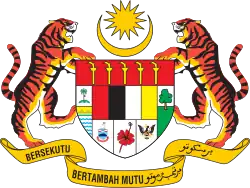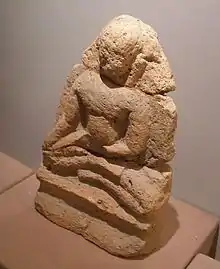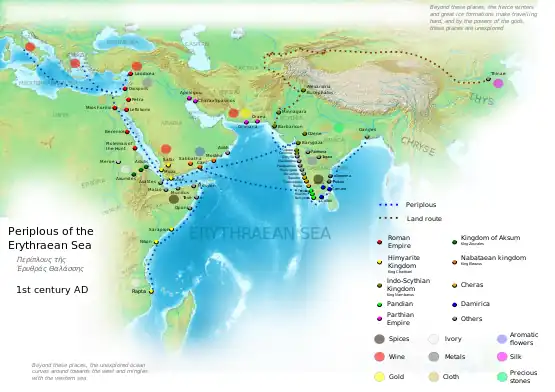History of Kedah
By around 788 BCE, a large settlement had been established on the northern bank of the Merbok River. The settlement was one of several in the Bujang Valley, covering the Merbok and Muda Rivers, about 1000 square miles. The Merbok settlement was built near the estuary of the tributary river, the Sungai Batu.[1][2] Around 170 CE groups of Hindu faith arrived at Kedah, joining them soon were peoples from nearby islands and from the northern Mon-Khmer region. At the same time traders from India, Persia and Arab, arrived the brink of the Malacca Strait, using Gunung Jerai the Kedah Peak as marking point. Ancient Kedah covered the areas of Kuala Kedah, Kuala Bara, Kuala Pila and Merpah.[3]
| History of Malaysia |
|---|
 |
|
|
Early west-coast trade centres are few in number as they were overshadowed by Kedah. Her nearness to the entrances to the Straits of Malacca – and more importantly – being on latitude 6° north of the equator, the same as Ceylon to the south of India, meant that ships sailing the Bay of Bengal in a sea lane heading due east or west between the two were in little danger of becoming lost. The early transpeninsular routeway is part of the sea trade route of the Spice Route for Arab, Persian, Tamil Nadu and India-to-China traders, as the route through the Straits does not seem to have been in general use. Early sea traders from the west, upon reaching the coast, engaged porters to transport goods by raft, elephant and man-carry along the rivers (Kelantan River, Pattani River, Pahang River, Muda River, Bernam River, Muar River, and others) to the opposite coast. The Sungai Muda in particular favoured the development of Kedah.
After the 7th century, Srivijaya subjugated Kedah, but due to her fame, Indian sources continue to depict Kedah. Early Kedah also supplied its own tin, and jungle products such as rattan, resin, honey, beeswax, elephants, ivory, areca nuts, sepang wood and black woods, as well as profiting from tax collections.
The early history of Kedah can be traced from various sources, from the prehistoric period to the archaeological site of Bujang Valley, the early maritime trade of India, Persia, and the Arabs to the written works of early Chinese pilgrims and early Chinese records, the Hikayat Merong Mahawangsa (known as Kedah Annals) to Al-Tarikh Salasilah Negeri Kedah.
Origins
Austronesians began migrating to the South East Asia Archipelago approximately 3,500 years before present. It is widely now accepted that Taiwan is the cradle of Austronesian languages. Some 4,000 years ago, Austronesian began to migrate to the Philippines. Later, some of their descendants started to migrate southwards to what is now Indonesia and eastwards to the Pacific islands.
Ancient history


Austronesians were great seafarers, colonising as far as New Zealand, Hawaii and Madagascar. In some regions they intermarried with the local inhabitants (Orang Asli), becoming the Deutero-Malays. Possibly as early as the 4th century BCE, Austronesians started to sail westwards in search of new markets for their products.[4][5]
Some Greco-Roman merchants in the 1st century CE described huge non-Indian ships coming from the east with rich cargoes, possibly from the Malay Archipelago. This would indicate that the Malay participated actively in Indian Ocean trade, and likely handled much of the traffic between Southeast Asia and India.[6]
Three kinds of craft are described by the author of the Periplus: light coasting boats for local traffic, larger vessels of a more complicated structure and greater carrying capacity, and lastly the big ocean-going vessels that made the voyages to Malaya, Sumatra, and the Ganges.[7]
.svg.png.webp)
Pre-Hindu civilisation
Deep in the pristine estuary of the Merbok River, lies an abundance of historical relics of the past. Ancient monumental ruins, buildings, temples, harbour and shipwrecks were all cloistered and entombed in the soil for two millennia.[8] At its zenith, the massive settlement sprawled across ~1000 kilometers and dominated the northern plains of the Malay Peninsula.[9][10] By contemporary accounts, the area is known as the lost city of Sungai Batu. Founded in 788 BC, it is among the oldest of civilisations in Southeast Asia and a potential progenitor of the Kedah Tua kingdom.
The historical landscape of the area was bound to a flourishing iron industry, with archaeological findings unearthed various historical mines, warehouses, factories, a harbour; together with a vibrant plethora of superior-quality ores, furnace, slag and ingots. Additionally, the peculiar Tuyere iron-smelting technique mobilised in Sungai Batu is hailed as oldest of its kind in the world. The produce was highly sought after and exported to various corners of the Old World, including ancient India, China, Middle East, Korea and Japan. Based on early Sanskrit reports, the area was known as "the iron bowl".[9][10]
The settlement also narrated a glimpse of the ancient religious undertakings prior to the mass Indianisation of the region. The early inhabitants of the Malay Archipelago was chronicled to be the adherence of indigenous animism and shamanism, strikingly similar to other indigenous religions of Eastern Asia, such as Shintoism. The ancient folk religion vividly characterised that every element of nature possessed a spirit, known as semangat. The semangat has the governing power to richly bless or mercilessly curse the society, hence the spirit should always be pleased and entertained. In Sungai Batu, archaeological evidence unmasked several ceremonial and religious architectures devoted to worshipping the sun and mountains.[9][10]
In addition to Sungai Batu, the early Malay archipelago also witnessed the monumental development of other subsequent ancient large urban settlements and regional polities, driven by a predominantly cosmopolitan agrarian society, thriving skilled craftsmanship, multinational merchants and foreign expatriates. Chinese records noted the names of Akola, P’an P’an, Tun-Sun, Chieh-ch'a, Ch'ih-tu, among few. Upon the fifth century AD, these settlements had morphed into sovereign city-states, collectively fashioned by an active participation in the international trade network and hosting diplomatic embassies from China and India.[9][10]
Medieval history

Early in the Medieval era, Kedah became part of Srivijaya (a major power in the Indian Ocean trade). This led to rivalries with the Indian states, especially the Chola Empire from the 9th to 13th centuries CE. The Cholas had a powerful merchant and naval fleet in the Indian Ocean and the Bay of Bengal. In the early 11th century, Tamil Chola King Rajendra Chola I sent an expedition to attack Kedah (Sri Vijaya) on behalf of one of its rulers who sought his assistance to gain the throne.The Chola fleets successfully defeated the Srivijaya empire, captured and sacked Kedah.
In ancient Kedah there is an important and unmistakably Hindu settlement which has been known for about a century now from the discoveries reported 1840s by Col. James Low, later subjected to a fairly exhaustive investigation by Dr. Quaritch Wales. Dr. Wales investigated no fewer than thirty sites round about Kedah . The results show this site was in continuous occupation for centuries, by people who under strong South Indian, Buddhist and Hindu influences.[11]
An inscribed stone bar, rectangular in shape, bears the Ye Dharma Hetu formula[nb 1] in South Indian characters of the 4th century CE, thus proclaiming the Buddhist character of the shrine near the find-spot (site I) of which only the basement survives. It is inscribed on three faces in Pallava script, or Vatteluttu rounded writing of the 6th century CE, possibly earlier.[12] One of the early inscription stones discovered by James Low, at Bukit Meriam and in Muda River, mention of Raktamrrtika. The word Raktamrrtika means ‘Red Earth’ (Tanah Merah).
Inscriptions, both in Tamil and Sanskrit, relate to the activities of the people and rulers of the Tamil country of South India. The Tamil inscriptions are at least four centuries posterior to the Sanskrit inscriptions, from which the early Tamils themselves were patronizers of the Sanskrit language.[13]
In Kedah, an inscription in Sanskrit dated 1086 CE has been found. This was left by Kulothunga Chola I (of the Chola empire, Tamil country). This too shows the commercial contacts the Chola Empire had with Malaya.[13]
An indigenous style develops

The Tamils coming from Southern India and the local Malays were already using the rounded script, or Vatteluttu writing styles which differed from the Devanagari script of Northern India. Vatteluttu was also commonly known as the Pallava script by scholars of Southeast Asian studies such as George Coedes and D.G.E. Hall. The Tamil script of Vatteluttu later evolved into Old Kawi script which was used in Java, the Philippines, and Bali as well.
There are stone inscriptions which indicate that the Kedah region at 400 CE or before was already an established trade centre. One of the early Malay texts include the karma verses refers to a king named Ramaunibham, who may be the first local ruler whose name is recorded in history. The history of this period showed the influence of Indian cultures on the region while the locals in return, influenced the Indians in their living skills on the sea and in the hills.
See also
Notes
- Vinodh Rajan (2 April 2012). "Ye Dhamma – The Verse of Causation". Vinodh's Virtual Cyber Space. Archived from the original on 20 March 2012. Retrieved 13 April 2012.
The Pali verse 'Ye Dhamma... ' is a popular verse in Buddhism that explains the heart of Buddhism Philosophy i.e Dependent Origination. The Sanskrit version of the verse is called "Pratityasamutpada Hridaya Dharani" [The Heart Dharani of Dependent Origination] with Om added to the beginning of the Verse, and Svaha added at the end, thus Dharani-fying the entire verse. The Pali version never seems to have had any specific title.
References
- "Sg Batu to be developed into archaeological hub". The Star. 3 October 2020. Retrieved 8 November 2020.
- "FIVE REASONS WHY YOU MUST VISIT THE SUNGAI BATU ARCHAEOLOGICAL SITE AT LEAST ONCE IN YOUR LIFETIME". Universiti Sains Malaysia. 14 November 2019. Archived from the original on 17 June 2021. Retrieved 8 November 2020.
- A concise history of Islam. Ḥusain, Muẓaffar., Akhtar, Syed Saud., Usmani, B. D. New Delhi. 14 September 2011. p. 308. ISBN 9789382573470. OCLC 868069299.
{{cite book}}: CS1 maint: location missing publisher (link) CS1 maint: others (link) - Bellwood P, Fox JJ, Tryon D (2006). The Austronesians: Historical and Comparative Perspectives. Australian National University Press. ISBN 9781920942854. Archived from the original on 2 April 2020. Retrieved 23 March 2019.
- Blench, Roger (2012). "Almost Everything You Believed about the Austronesians Isn't True" (PDF). In Tjoa-Bonatz, Mai Lin; Reinecke, Andreas; Bonatz, Dominik (eds.). Crossing Borders. National University of Singapore Press. pp. 128–148. ISBN 9789971696429. Archived (PDF) from the original on 30 December 2019. Retrieved 23 March 2019.
- Dick-Read, Robert (2005). The Phantom Voyagers: Evidence of Indonesian Settlement in Africa in Ancient Times. Thurlton.
- Sastri, K.A. Nilakanta (2000) [1935]. Cholas (fifth printing ed.). Chennai: University of Madras. pp. 86 & 318.
- Mok 2017.
- Pearson 2015
- Hall 2017
- Sastri, K.A. Nilakanta (1949). South Indian Influences in the Far East. Bombay: Hind Kitabs Ltd. pp. 82& 84.
- Sastri, K.A. Nilakanta (1949). South Indian Influences in the Far East. Bombay: Hind Kitab Ltd. pp. 28& 48.
- Arokiaswamy, Celine W.M. (2000). Tamil Influences in Malaysia, Indonesia, and the Philippines. Manila s.n. p. 41.
{{cite book}}: CS1 maint: location missing publisher (link)
Sources
- Hall, Thomas D. (2017), Comparing Globalizations Historical and World-Systems Approaches, Springer, ISBN 9783319682198
- Mok, Opalyn (9 June 2017). "Archaeologists search for a king in Sungai Batu". The Malay Mail.
- Pearson, Michael (2015), Trade, Circulation, and Flow in the Indian Ocean World, Palgrave Series in Indian Ocean World Studies, Palgrave Macmillan, ISBN 9781137566249
Further reading
- The Encyclopedia of Malaysia: Early History, Volume 4 / edited by Nik Hassan Shuhaimi Nik Abdul Rahman (ISBN 981-3018-42-9)